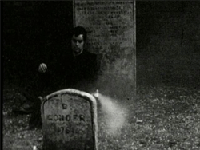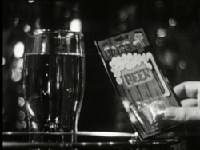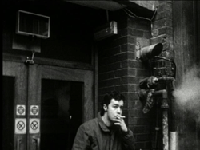C'NT Programming - Michael James Jones
SOMETHING IS HAPPENING
 Michael Jones' mixed media installations reference a myriad of sources. His associated sensibility and intelligence draws from, among other things, film history, contemporary art and his own sense of place and humour. In his film installation The Economist (2006), Jones references the opening and closing of Antonioni's 1966 film Blow Up. Collin Gardner encapsulates Jones' concerns much more succinctly than I am able:
Michael Jones' mixed media installations reference a myriad of sources. His associated sensibility and intelligence draws from, among other things, film history, contemporary art and his own sense of place and humour. In his film installation The Economist (2006), Jones references the opening and closing of Antonioni's 1966 film Blow Up. Collin Gardner encapsulates Jones' concerns much more succinctly than I am able:
Blow-Up would thus seem to be a zero-degree text demonstrating the impossibility of a phenomenological reduction. The pre-reflective and the reflective, embodied and hermeneutical relations with the world would thus imbricate themselves in a chiasmus of endless reversibility. To separate them into simple binaries would be impossible. In this respect, the film's qualified essential structure would be this chiasmus.1
That sums up that one nicely I think!
Next!
Jones' cemetery piece from his London Fragments installation (2005-06) combines the grainy black and white texture of early silent horror films with contemporary tagger techniques. A sensitive Baudelaireian young man (the artist) lounges in a foggy English cemetery musing about god-knows-what. As the fog begins to clear the man reveals an aerosol can and proceeds to spray fake fog into the air creating an even more misty, gothic, almost erotic Pre-Raphaelite ambience.
The fake beer segment from the same installation depicts what appears to be a lower class lad (again, the artist) on a limited budget, drinking fake powdered beer. Perhaps our protagonist is jealously musing over the success of the dandies, Gilbert and George who gained critical and subsequent financial success after they get drunk in their 1972 video Gordon's Makes Us Drunk. The difference of course is that G and G, in their trademark suits are drinking expensive gin in a subdued elegantly sparse Edwardian drawing room while Jones, in his soiled flannel shirt, guzzles his concoction in a grubby pub.
The third segment of London Fragments is of a man (yet again, the artist) smoking a fake cigarette in a no-smoking area in a gritty London alley. Fake fog, fake beer and fake cigarettes would seem to imply that the artist himself is a big liar... but he is not. Jones has stated, “On one hand, my film installations encourage the imagined narrative through the sensory seduction of the cinematic experience. On the other, the arrangement of materials and gestures performed are employed to demystify the cinematic image by exposing the world on screen as the sum of parts; film stock, lighting, lenses and smoke. Whether re-filming a scene of youth rebellion from an iconic 60s film or re-doing conceptual art performances, these installations re-stage the cusp between the ‘truth’ within the material conditions of presentation and reception.”2
Graveyard (London Fragments) Pint (London Fragments) Smoke (London Fragments)
Jones has had many innumerable chances to go mainstream but he is steadfast and uncompromising in his commitment to his own particular vision and rejects any possibility of selling out to commercial hoopla. When given the chance to direct a film starring Jeff Funnell and myself, he turned down the offer. To have been shot in London's Regents Park (the key site in Blow Up) the opening scene of this aborted idea places Jeff and I lounging in those pay-to-sit canvas chairs watching the pigeons and then later sitting there munching on fried pigeon wings. Hollywood called, but Jones hung up.
In his most recent work Do You Want Me to Talk or Do You Want Me to Shut Up? (2008), Jones' grandmother builds a fire and proceeds to talk. Inspired by Ed Ruscha’s 1977 painting of a fire in a fireplace (No End To Things Made of Human Talk) Jones’ tape is one of his few works containing sound, which is crucial in this case as the work's sustainability is contained within the dialogue.
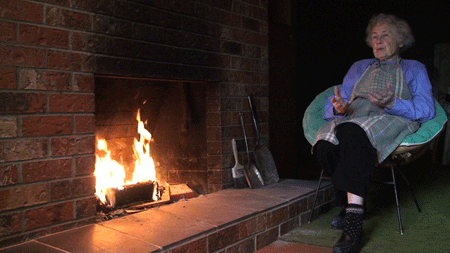 The tape begins with the woman building a fire in her fireplace. The only sound in the first scene is her opening the box of fake (yet again!) logs, removing one, trying unsuccessfully to unwrap it and finally plopping it down on the hearth prior to throwing it in the pit and lighting it afire. Strange as it may seem, the short, resonant sounds in this scene rivet the viewer's attention and anticipation. The woman then sits down and proceeds to watch the fire for a couple of minutes before starting to talk. This silence is reminiscence of Gilbert and Georges’ pause before beginning their repeated droning monologue: “We get very drunk on Gordon’s.” The comparison stops there, as when Jones’ grandmother begins to speak, she narrates stories about her ancestors as well as an anecdotal tale of coincidence experienced in the 1940s. At times, she has what appear to be lapses of memory but then her narration jump cuts forward and backward somehow tying the threads together in a sweetly coherent manner. Eventually, as many elderly people are wont to do, she feels it is time to quit and she does so matter of factly .
The tape begins with the woman building a fire in her fireplace. The only sound in the first scene is her opening the box of fake (yet again!) logs, removing one, trying unsuccessfully to unwrap it and finally plopping it down on the hearth prior to throwing it in the pit and lighting it afire. Strange as it may seem, the short, resonant sounds in this scene rivet the viewer's attention and anticipation. The woman then sits down and proceeds to watch the fire for a couple of minutes before starting to talk. This silence is reminiscence of Gilbert and Georges’ pause before beginning their repeated droning monologue: “We get very drunk on Gordon’s.” The comparison stops there, as when Jones’ grandmother begins to speak, she narrates stories about her ancestors as well as an anecdotal tale of coincidence experienced in the 1940s. At times, she has what appear to be lapses of memory but then her narration jump cuts forward and backward somehow tying the threads together in a sweetly coherent manner. Eventually, as many elderly people are wont to do, she feels it is time to quit and she does so matter of factly .
Well, what does one make of all this? In October of 2007 Jeff Funnell and I went to England and Jones was kind enough to take us two seniors under his protective wing and show us some of the sights and sounds of swinging London. Unlike most Londoners, Jones seemed to know his way around and late one pub hoping night we ended up in a place called The Spanish Bar deep in the bowels of Soho.
The place was jam packed and very noisy. Jeff and I were a bit nervous until, quite coincidentally, “American Woman” by the Winnipeg group The Guess Who came blaring out of the DJ’s amps. Jeff and I began to tear up and feel right at home. Shortly, our tears of joy turned to ones of terror and our false sense of security was shattered when a group of tattooed and pierced thugs arrived and began lurking in the shadows with their digital cameras much like David Hemmings did with his now antiquated analog Nikon back in 1966. Thank god, we were put back at ease when these frillyed-up-hooligan-fops emerged from the darkness of their deranged mood and engaged Jones in a friendly conversation about post-structural architecture or some such thing. With them was an older woman who kept butting in with Cockney garbled, but somehow well articulated, comments on symbiotic situational esthetics. When Jones matched her thought for thought she seemed to take a bit of a shine to him. (As an aside, we later found out she, unlike Jones, was very, very, very rich.)
Anyway, at one point this woman took the three of us out on the street to smoke cigarettes and when she asked Jones for money to buy more whiskey and he refused, she wound up and violently slapped his face. Stunned, but somehow keeping calm and collected, Jones asked why she had slapped him. She replied that he was a young man ”who needed straightening out”.
Instantly, Jones’ calm and collection evaporated. "That's it! I've had it!" he screamed. "I am going up to Iceland." And he disappeared into real London fog. Jeff and I thought he meant some other pub for expatriates but as it turned out he meant the actual country. The last we heard, he is now in Reykjavík putting the finishing touches on a documentary film about the late Bobby Fischer.
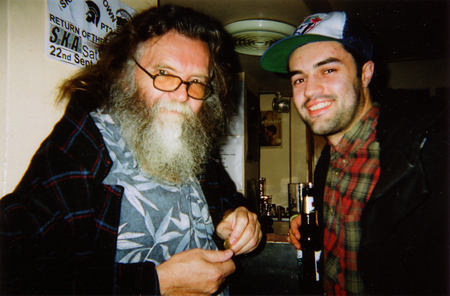 Michael Jones' persona is open ended, deadpan, sometimes opaque, sometimes transparent and his films and installations beg the question of meaning and we are richer for it. He notes: “Through the suggestive power of an object, artifice is reassigned as a means to critique the way the presentation of information is sometimes employed to stand in for the reel (sic?).”3
Michael Jones' persona is open ended, deadpan, sometimes opaque, sometimes transparent and his films and installations beg the question of meaning and we are richer for it. He notes: “Through the suggestive power of an object, artifice is reassigned as a means to critique the way the presentation of information is sometimes employed to stand in for the reel (sic?).”3
His work is real and as another aside, his “critique” broke my long song-writing block. I wrote a brilliant lyric if I do say so myself: "Something is happening here and you do know what it is, don’t you Mr. Jones."
On that note, I think it is time for me to matter-of-factly stop.
John Will
February 2008
Bobby Fischer & Michael Jones, Reykjavík, December 2007
1. Collin Gardner, Antonioni's Blow Up and the Chiasmus of Memory. Journal of Neuro-Aesthetic Theory, No 2, 2002.
2. Michael Jones, Artist statement for his exhibition at the Bilton Centre for Contemporary Art, February 2008.
3. Ibid.
Michael Jones' CV | Images | Statement | Something is Happening Here - a text by John Will
